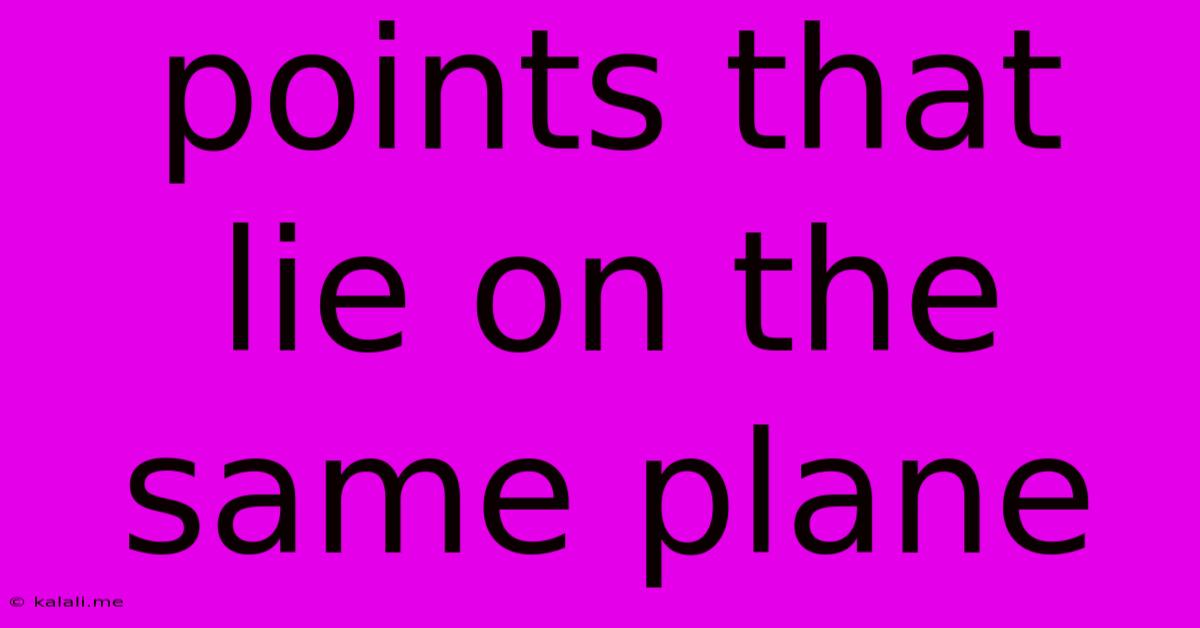Points That Lie On The Same Plane
Kalali
Jun 06, 2025 · 3 min read

Table of Contents
Points That Lie on the Same Plane: A Comprehensive Guide
Meta Description: Understanding coplanar points is crucial in geometry. This article explores the definition, identification, and significance of points lying on the same plane, providing clear explanations and examples.
Points that lie on the same plane are called coplanar points. This fundamental concept in geometry underpins many higher-level mathematical principles. Understanding coplanarity is essential for visualizing and solving problems involving three-dimensional space and shapes. This article will delve into the definition, identification, and significance of coplanar points.
Defining Coplanar Points
In simple terms, coplanar points are points that all reside on a single plane. A plane is a flat, two-dimensional surface that extends infinitely in all directions. Think of a tabletop, a sheet of paper, or even the surface of a perfectly still lake – these all represent examples of planes. Any number of points can be coplanar; two points are always coplanar, three points are usually coplanar, and four or more points might or might not be.
Identifying Coplanar Points
Identifying whether points are coplanar can involve different methods depending on the information given. Here are some common scenarios:
-
Visual Inspection: If you have a diagram showing points in three-dimensional space, you can often visually determine coplanarity. If the points seem to lie on the same flat surface, they are likely coplanar. However, this method is not always reliable, especially for complex spatial arrangements.
-
Using Vectors: Vector algebra provides a powerful tool for determining coplanarity. If you have the coordinates of three or more points, you can form vectors between pairs of points. If the vectors are linearly dependent (meaning one vector can be expressed as a linear combination of the others), then the points are coplanar. This involves calculating the scalar triple product. A scalar triple product of zero indicates coplanarity.
-
Using Equations of Planes: If the equation of a plane is known (typically in the form Ax + By + Cz + D = 0), you can substitute the coordinates of each point into the equation. If the equation holds true for all points, then the points are coplanar.
-
Collinear Points: If all points lie on a straight line, they are automatically coplanar. A straight line can always be contained within a plane.
Significance of Coplanar Points
The concept of coplanarity has significant implications across various areas of mathematics and its applications:
-
Geometry: Understanding coplanar points is fundamental in studying polygons, polyhedra, and other geometric shapes. Many geometric theorems and proofs rely on the properties of coplanar points. For example, determining if a set of points forms a plane figure relies on the coplanarity of those points.
-
Linear Algebra: As mentioned earlier, vectors and linear dependence are used to determine coplanarity, highlighting the connection between geometry and linear algebra.
-
Computer Graphics: Coplanarity is crucial in computer graphics for efficient rendering and calculations involving 3D models. Identifying coplanar polygons can optimize algorithms and reduce computational complexity.
-
Physics and Engineering: In fields like physics and engineering, understanding coplanarity is essential for analyzing forces, moments, and equilibrium in structures and systems.
Examples of Coplanar Points
-
Vertices of a triangle: The three vertices of any triangle always lie on the same plane.
-
Vertices of a square: The four vertices of a square always lie on the same plane.
-
Points on a flat surface: Any points that lie on a flat surface, such as a tabletop or a wall, are coplanar.
Non-Coplanar Points: An Exception
While many points might appear coplanar, it's important to remember that not all sets of points share this property. For example, the four vertices of a tetrahedron (a three-dimensional shape with four triangular faces) are not coplanar. They define a three-dimensional space, not a two-dimensional plane.
In conclusion, understanding coplanar points is a cornerstone of geometric understanding. The ability to identify and utilize the properties of coplanar points is crucial for solving complex problems in various fields. Whether using visual inspection, vector methods, or plane equations, the determination of coplanarity underpins many advanced mathematical concepts.
Latest Posts
Latest Posts
-
Why Is My Car Jerking When I Drive
Jun 07, 2025
-
Bible Verse A Cord Of Three Strands
Jun 07, 2025
-
Light Switch And Outlet Wiring Diagram
Jun 07, 2025
-
How To Delete Text On Android
Jun 07, 2025
-
Its Gonna Be On You Meaning
Jun 07, 2025
Related Post
Thank you for visiting our website which covers about Points That Lie On The Same Plane . We hope the information provided has been useful to you. Feel free to contact us if you have any questions or need further assistance. See you next time and don't miss to bookmark.